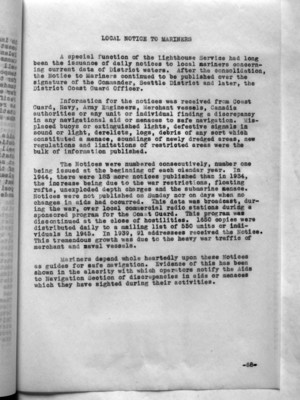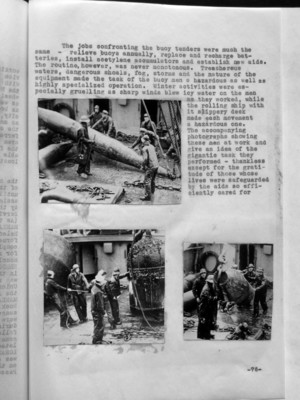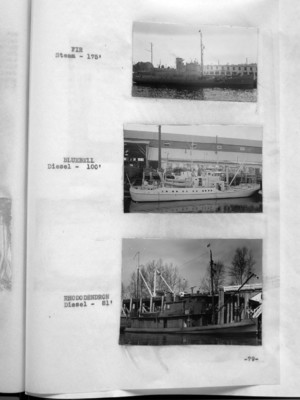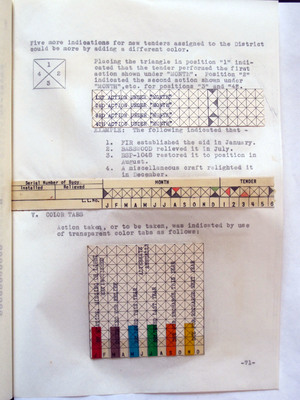Pages That Need Review
Coast Guard District narrative histories 1945
88
LOCAL NOTICE TO MARINERS
A special function of the Lighthouse Service had long been the issuance of daily notices to local mariners concerning current data of District waters. After the consolidation, the Notice to Mariners continued to be published over the signature of the Commander, Seattle District and later, the District Coast Guard Officer.
Information for the notices was received from Coast Guard, Navy, Army Engineers, Merchant vessels, Canadia authorities or any unit or individual finding a discrepancy in any navigational aid or menaces to safe navigation. Misplaced buoys or extinguished lights, defective signals in sound or light, derelicts, logs, debris of any sort which constituted a menace, soundings of newly dredged areas, new regulations and limitations of restricted areas were the bulk of information published.
The Notices were numbered consecutively, number one being issued at the beginning of each clendar year. In 1944, there were 183 more notices published than in 1934, the increase being due to the war restrictions, floating rafts, unexploded depth charges and the submarines menace. Notices were not published on Sunday nor on days when no changes in aids had occurred. This data was broadcast, during the war, over local commercial radio stations during a sponsored program for the Coast Guard. This program was discontinued at the close of hostilities. 1850 copies were distributed daily to a mailing list of 550 units or individuals in 1945. In 1939, 91 addresses received the Notice. This tremendous growth was due to the heavy war traffic of merchant and naval vessels.
Mariners depend whole heartedly upon these Notices as guides for safe navigation. Evidence of this has been shown in the alacrity with which operators notify the Aids to Navigation Section of discrepancies in aids or menaces which they sighted during their activities.
89
CARD FILE SYSTEM
A card record system was developed in the Aids to Navigation Section for each buoy in the District, arranged geographically in a visual card file with visual color signals indicating the general progress in buoy relief work and other pertinent information. On the face of the card was typed the name and the Light List number or page number of the buoy. The various activities or conditions were noted on the card according to the following outline as indicated on the attached key:
I. YEAR
The current year was typed below the heading "YEAR". Only one line was required for the year unless one or more of the following conditions existed: a. More than one buoy installed in one year. b. More than four sections in one year. c. Extinguished and off-station same month. d. Relieved, relocated, changed type of damage same month.
II. SERIAL NUMBER OF BUOY Under this heading the serial numbers of the buoys were typed whether installed or relieved.
III. MONTH Each line in this section was divided into 21 squares, one for each month of they year. Each square was divided into 4 triangles. By placing different colored triangles in the various positions, the section taken was indicated according to the following legend:
-69-
90
Year Installed Relieved
Established Relieved Missing or out of position Restored to position Extinguished Relighted Relocated Changed type Recharged Discontinued Damaged Inspected
IV. TENDER
The tender carrying out the activity indicated was recorded by making a triangle in column 1, 2 ,3 4, 5, or 6 under the heading 'TENDER" according to the following legend:
Col. 1 black triangle -MANZANITA Col. 2 black triangle- FIR Col. 3 black triangle-ROSE Col. 4 black triangle-[REODODENDRON?] Col. 5 black triangle-[OG-65302-D?] Col. 6 black triangle-Mis. Unit Col. 1 red triangle -Basswood Col. 2 red triangle-Bluebell Col. 3 red triangle-BSP-1048 Col. 4 red triangle- (New tender) Col. 5 red triangle-(New tender)
Chart to right of IV. Tender
93
REVERSE SIDE
On the reverse was typed the following information: 1. Name of buoy 2. Light List or Page Number of buoy 3. Authority for establishment 4. Authorized equipment 5. Characteristics 6. Remarks
OPERATION In order to keep the record current, the following reports were checked against it: 1. Buoy Report 2. Approved Form 2609 3. Battery Installation Report 4. Accumulator Installation Report 5. Completed Tender Order 6. Completed Work Request 7. Inspection Report 8. Other reliable sources
The following page is a guide card for marking and placing color tabs on the buoy cards.
96
The jobs confronting the buoy tenders were much the same - relieve buoys annually, replace and recharge batteries, install acetylane accumulators and establish new aids. The routine, however, was never monotonous. Treacherous waters, dangerous shoals, fog, storms and the nature of the equipment made the task of the buoy men a hazardous as well as highly specialized operation. Winter activities were especially gruelling as sharp winds blew icy water on the men as they worked, while the rolling ship with it slippery deck made each movement a hazardous one. The accompanying photographs showing these men at work and give an idea of the gigantic task they performed - thankless except for the gratitude of those whose lives were safeguarded by the aids so efficiently cared for.
102
Standard Colors for Minor Aids
Port Starboard Black Red White White
Wooden House Ladder White Piling Unpainted
Lights ashore are to be painted in alike manner.
Port Starboard Black Black White White
Steel House Ladder-White Piling Unpainted
Port Starboard Port Starboard Black Red Black Red White White White White
Ladder - White Piling Unpainted
Battery Box Gas Light with Center Pile
105
Chapter Notes Foreward (Page 2) - Letter from the Commandant to members of the former Lighthouse Service eligible for appointment or enlistment in the Coast Guard, dated 25 November, 1939.
Light Stations (page 1) - Coquille River and Warrior Rock Lighthouses were originally "keeper stations" but were changed to unwatched lights in 1940.
Lightships (Page 15) - Because of the confined conditions aboard Lightships, men were granted 180 days personnel liberties as per anuum. It was found that the men became weary after spending some time aboard Lightships on exposed stations, and it was necessary to bring them ashore at frequent periods. It was the practice of the Lighthouse Service to make a trip into the Lightship every four weeks, using one of the buoy tenders for this purpose and, at the same time delivering provisions and water. After spending 8 weeks aboard, the members of the crew and officers were given four weeks liberty ashore. This arrangement proved very satisfactory for a period of years. Under the Coast Guard, however, it was felt that the 8 week period of duty was too long. The 4-week period of duty was not provided for under Coast Guard Regulation and was unsatisfactory as enlisted men were entitled to quarters and rations. The question was raised as to whether the enlisted men in the lower grades would have sufficient funds to finance themselves on these long periods of liberty. It was standard Coast Guard practice to provide 10 days shore duty to keep the crews contented.
Radiobeacons (Page 21) - Radiobeacon peace time operation (continuous - clear weather) was resumed at the end of the war.
106
Blackout (Page 43) - ^1 Blackout Plan. File 00-626 (14220/X-12)
Racon (Page 56) - ^1 Aray and Navy correspondence regarding the initial installations referred to the RADAR Beacons as "Raydon" and "Radon" as well as RACON
(Page 57) - ^2 Tatoosh Island RACON was established by the Navy on 1 February, 1943, and discontinued a year later.
(Page 57) - ^3 BuShip's Confidential letter, Serial C-979-384, dated 22 November, 1943.
(Page 57) - ^4 Directive from the Chief of Naval Operations(Op-20-Z) to The Commandant, U.S. Coast Guard, serial 0569420, Confidential, dated 8 June, 1944
91
Five more indications for new tenders assigned to the district could be more by addinga different color. placing the triangle in position "1" indicated that the tender performed the first action shown under "MONTH". Position "2" indicated the second action shown under "MONTH", etc. for positions "3" and "4".









